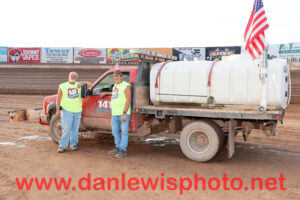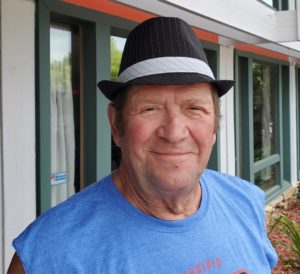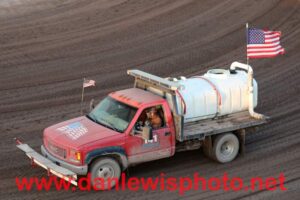The Scoop
MERLE LISOWE – BREAKING DOWN THE ART OF TRACK PREP
Posted on: Wednesday October 16, 2024

Merle Lisowe (right) poses with Tom “Bomber” Graycarek by the 141 Speedway water truck. (danlewisphoto.net)
After preparing dirt tracks for 30 years, Merle Lisowe figures he’s logged close to 280,000 miles making left hand turns.
The soon-to-be-73-year-old remains a key part of the team at 141 Speedway in Francis Creek, Wisconsin. With the consistent track conditions the quarter-mile clay oval serves up, The Francis Creek oval enjoyed a monumental 183 car weekly average in six divisions at the end of 2024. That average car count remains the highest in the United States for three years in a row.
It’s those consistent track conditions that draw so many cars to the Manitowoc County oval on Saturday nights. Back in 1994, Lisowe was one of those drivers who wasn’t particularly happy with the track conditions at his home track at the time – the now defunct Chilton Speedway at the Calumet County Fairgrounds. “I was racing in the Pro 4 class and the guy we had preparing the track at Chilton wasn’t doing it very well,” Lisowe said. “The track was often overly wet and very bumpy and I piped up and said “It has to be better than this.”

Merle Lisowe
So Lisowe stepped up and took over the track prep chores. At that time he was a board member of the Calumet County Racing Association (CCRA) – the group that was running the Chilton racing program in the mid 1990’s.
Being a farmer most of his adult life, Lisowe admittedly has an edge of sorts on discovering what that clay and dirt will do when it’s dug up, watered, and packed into a racing surface. “(Being a farmer) definitely helps in that area I’d say,” Lisowe admitted. “During the day as I water, I simply watch the color of the track. The darker it gets, the better it is. Then you know the clay is absorbing the moisture. With that red clay on the farm – when you work it wet it will get hard as cement. That’s what I try to do here at 141. Get that surface hard. Get it dry slick. Build a little bit of a berm. And everybody is happy.”
Lisowe’s schedule with his track prep week begins typically on Thursdays. “At 141, we usually have a practice session on Thursday nights so I prep the track for that,” Lisowe explains. “After practice is done, I’ll soak the track with some water, and then head home and get a little sleep. I’ll return Friday morning and keep working 141’s track until about noon. Then I jump in the truck and head over to Luxemburg and help with their track for their Friday night show.”

Merle Lisowe figures he’s logged more than 280,000 miles prepping dirt tracks in a 30 year career. (danlewisphoto.net)
Merle then gets up often at the crack of dawn and heads over to 141 to put the finishing touches on his masterpiece for Saturday’s show in Francis Creek. Obviously with an average of 183 cars in six classes pounding the track surface, keeping some bite on the track surface can pose some legit challenges. “Some drivers grumble that I should put more tack in it but a lot of guys just want the surface smooth,” Lisowe said. “Sometimes when the track gets hard you get a few crumbles of clay and we can push the marbles to the top. If we mist it properly on the top, we can create three or sometimes four grooves of racing. I try to keep at least a groove up top and we keep the bottom wet to get at least two grooves of racing.”
According to Lisowe, it’s much easier with fewer cars pounding the track to keep that surface tacky and racy. “Luxemburg’s got some really good clay to begin with and the track’s we’ve had there this year were really good,” Lisowe said. “That really helps keep the moisture in the track when it’s all clay. 141’s surface these days is about half clay, half rubber. We still find a way to make it work.”
Just exactly how Lisowe preps a track can vary when a traveling series comes to town – like the IRA Outlaw sprint car series, for example. “When IRA shows up, I work the clay up a little bit more to get more moisture in the surface,” Lisowe explained. “When sprint cars roll into town I work a top groove and a bottom groove. When there are some dry slick lanes on the track they can still do their slide jobs. The more moisture you put in, though, you run the risk of the track getting rough. And if it’s not smooth I’ll get bitched at by the drivers.”
For those of us who’ve been around this sport for awhile, we all remember in the ’70’s, ’80’s and even into the ’90’s when most track promoters required drivers to pack the track. With a few exceptions when rain showers move through either on race day or during the program, drivers typically don’t have to pack track much anymore. “I remember in the ’90’s at Chilton, we would pack track when it was really sloppy wet,” Lisowe said. “I remember the crews would pull so much clay off the cars they’d make snowmen out of clay! But these days in those first few heats, some of those cars may take a little clay from the track. But it’s not like it used to be years ago. But you still need to replenish the track surface with clay every year or two. In fact after our last race at 141, they are laying down another 60 loads of clay, and it’s always best to get that clay on the track before the frost sets in.”
Lisowe points to one year when the clay at the fairgrounds track at Chilton was laid down in the spring. It caused all sorts of track prep issues. “It was so bad that I had to grade all of that clay off the track,” Lisowe recalled. “We had to shut down for two or three weeks because of that. That’s why it’s important to put that new clay down before the snow flies.”
So what are Lisowe’s key pieces of track equipment that help him prep a near perfect dirt track? Lisowe has a sheepsfoot and a grader at his disposal, along with a water truck. “When Tim Czarneski took over here as one of the partners, he suggested that I try a piece of equipment that he’s used in the landscaping business called a Harley rake,” Lisowe said. “I told him flat out ‘that thing ain’t ever going to work.’ But I tried it, and honestly it’s probably the best piece of track prep equipment I’ve ever used. It really helps keep the track smooth, and you don’t have to water it nearly as much. It makes for less work on my end and helps put out some of the best track surfaces ever.”
Like any farmer, Lisowe watches the weather closely on a daily basis. “I watch the forecast daily and I really look at what direction the wind will be blowing, too,” Lisowe said. “It’s never easy keeping everybody happy. It seems like the modified, sportmod and stock car drivers want the track dry. The street stocks, grand nationals and four cylinders like a little bit more tack in the racing surface. You do your best to make everyone happy to the best of your ability.”
Lisowe does have a supporting cast. His longtime assistant Tom ‘Bomber’ Graycarek has been chipping in with the track prep at 141. “Kyle Domalick has started helping me out a lot and I can see him eventually taking this track prep thing over down the road,” Lisowe said. “But I see myself doing this until I’m at least 80, maybe even longer.”
Lisowe can normally tell if it’s been a good night when the feature races are done on any given night. “When those top four guys always pull into the claim area, if you get a thumbs up from them, they are happy. Once in a blue moon you might get a middle finger thrown your way but that doesn’t happen too often. I just shrug my shoulders. What else can you do? I take a lot of pride in what we do.”


